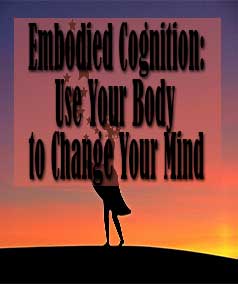I’ve spoken a lot on this blog about the benefits of changing your mind (thoughts, beliefs, etc) to improve your physical body, your relationships, your experience of the world, and your life in general. One way to help you change your thinking is by using your body and environment. Here we’ll look at what research has shown in the fields of embodied cognition psychology, and a subset of it called enclothed cognition psychology. Let’s look at what they are and how you can use these insights to help you change your mind.
What is Embodied Cognition Psychology?
The prevailing view of science over the last couple hundred years involves the idea that the brain is the “control center” of the body – sitting there outputting commands – and that the mind and body are separate, distinct entities. This theory of “dualism” was embraced by Rene Descartes in the 17th century, and it was popularly held by most mainstream scientists until only recently.
There is a great difference between mind and body, inasmuch as body is by nature always divisible, and the mind is entirely indivisible… the mind or soul of man is entirely different from the body.
Rene Descartes
Embodied cognition, however, opposes that view. It is a theory that began in the beginning of the 20th century (Martin Heidegger and John Dewey), but has only been really studied in the last few decades. In embodied cognition, the idea is that the body and mind are connected, and our bodies and the environment can influence or even determine our thoughts and beliefs. So it’s not that the brain is sitting there spitting out orders and directing everything. Rather, sometimes the actions of our bodies determine what we think, feel, and believe. It can go both ways.
Examples of Embodied Cognition in the Literature
To understand embodied cognition better, it’s helpful to look at a few examples of it that have been published in the scientific literature.
- A 2011 study tested people who leaned to the left versus those who leaned to the right. They found that leaning to the left made the size of the Eiffel Tower seem smaller than it did to those who leaned to the right.
- Participants who chose to wear an embarrassing costume while walking across a college campus were compared with those who didn’t wear a costume. Those who wore the costume had a distorted distance perception, meaning they judged the distance they walked to be much shorter than it was in actuality. The ones who didn’t wear a costume showed no such distortion.
- Researchers have found that when making judgments about objects in photographs, people will take the perspective of a person in the picture instead of their own. For example, when shown a photo of an apple and a banana, then asked about the location of the apple compared to the banana, the results depended on whether the picture included a picture of a person. If there was a person in the picture, the respondents answered according to the person in the picture’s perspective instead of their own.
- In a study done by Yale psychologist John Bargh, participants holding warm as opposed to cold cups of coffee were more likely to judge a confederate as trustworthy after only a brief interaction.
- At the University of Toronto, subjects were asked to remember a time when they were either socially accepted or socially snubbed. Those with warm memories of acceptance judged the room to be 5 degrees warmer on the average than those who remembered being coldly snubbed.
- Squeezing a soft ball influenced subjects to perceive gender neutral faces as female while squeezing a hard ball influenced subjects to perceive gender neutral faces as male.
There are a lot more examples, many of them more detailed and complex, but the point is that a physical action of the body influences the way the mind thinks or perceives.
What is Enclothed Cognition?
Enclothed cognition is just an off-shoot of embodied cognition. Enclothed cognition studies have found that the clothes you wear influence your thinking. Here’s a couple examples:
- In 2012, researchers at Northwestern University tested people to see how much the clothes they wear affects how they think. In one experiment, they had people wear a white doctor’s lab coat. Some of the people were told it was a doctor’s coat. Others were told it was a painter’s coat. Another group did not wear the lab coat. Tests determined that those who wore the coat and thought it was a doctor’s coat made half as many errors when asked to detected incongruities in a test than those without the coat. Also, those with the coat showed greater focus and attention than the other groups, indicating that what you wear influences how you think.
- Sales managers often use this knowledge about enclothed cognition. Many call centers require their salespeople to dress up for work even though no customers can see them in their workplace. This is because when people dress in business attire, they tend to speak in a more professional manner and act more professionally than if they were dressed is casual street attire.
Here is a video detailing other results from studies about enclothed cognition:
Why This is Useful
To bring about change in your own life and in the world around you, you first need to change your thinking. A change in thinking leads to changes in behavior, and it’s these actions which bring about the change we experience in our little personal worlds. So then the question becomes, “What is an effective way to change my thinking?” Of course, we have the option of gaining new knowledge or accumulating new evidence that supports new beliefs. So one more tool in your arsenal to bring about change in your world comes from these studies on emotional cognition (and its subset, clothed cognition).
Knowing that your body, your physical actions, and your environment can influence the way you think and perceive simply brings you new ways to set yourself up for success. Just as a small example, say you’re a chronic worrier who spends most of the time ruminating about the future. Studies in emotional cognition show that people who lean back slightly are more apt to think about the past, while those who think about the future tend to lean forward slightly. You are trying to stop thinking about the future all the time, so you could purposely remind yourself to lean backwards throughout the day to help yourself reach the goal you’ve set for yourself. Use your body to influence your mind.
 Motivational speaker Tony Robbins talks a lot about using your physiology to influence your thinking and your feelings. For example, say you feel rather down and depressed. He illustrates that you can change your physiology to life your mood. Look upwards instead of looking down. Instead of slumping your shoulders, square them and sit or stand up straight. Take deep breaths. Smile. Don’t speak in a slow, monotone voice. Instead, vary your pitch, gesture with your hands and face, as a passionate person would speak. Quicken the pace at which you speak and move. Walk as if you’re on a mission. Your thoughts and mood will follow the actions set forth by your body.
Motivational speaker Tony Robbins talks a lot about using your physiology to influence your thinking and your feelings. For example, say you feel rather down and depressed. He illustrates that you can change your physiology to life your mood. Look upwards instead of looking down. Instead of slumping your shoulders, square them and sit or stand up straight. Take deep breaths. Smile. Don’t speak in a slow, monotone voice. Instead, vary your pitch, gesture with your hands and face, as a passionate person would speak. Quicken the pace at which you speak and move. Walk as if you’re on a mission. Your thoughts and mood will follow the actions set forth by your body.
What do you think? Have you ever noticed how your physical actions influence your thinking? What about your clothes – do you notice that you think and act differently when you’re wearing old sweatpants with a raggedy T-shirt than when you’re all dressed up? Share your thoughts in the comments below.






